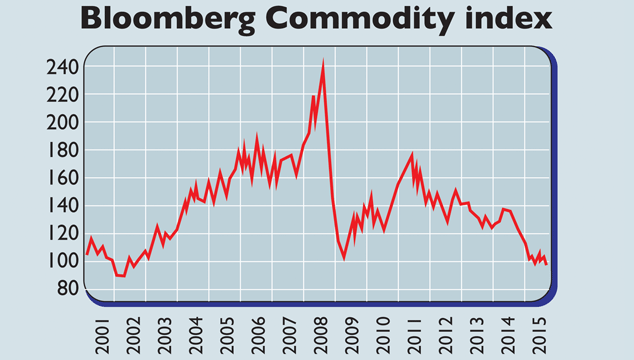
Last decade’s long bull market in raw materials, often called the “commodities supercycle”, is now a distant memory. This week the Bloomberg Commodity index, which tracks 22 hard and soft raw materials, fell to a 13-year low. It is down by almost 60% from its 2008 peak.
Prices fell across the board, with gold sliding to a five-year-low over ten days, its longest losing streak since 1996. Oil tumbled – US futures are at a six-month low below $50 a barrel, while Brent crude hit a three-month trough. Industrial metals are ailing too, with copper close to a six-year low. And a bumper US harvest has hit grain prices.
What the commentators said
This is “one of the great bear markets”, said economist.com’s Buttonwood. Had stocks fallen by this much from their peak, the papers would be full of “collapse and calamity”. The reason they aren’t is that not many people are directly invested in commodities. But these prices do matter: the Arab Spring began as a protest against food prices. Commodity-producing countries now face a fall in export earnings, jobs and growth.
“You’ve got unstinting supply increases and a weak outlook for demand across the board,” said Michael McCarthy of CMC Markets. Annual growth in China, whose appetite for metals underpinned the supercycle, has fallen to 7%, the lowest since 1990. The recent stock- market meltdown has revived fears of a hard landing. The global picture looks lacklustre too, with the International Monetary Fund trimming its 2015 global growth forecast from 3.5% to 3.3%.
US dollar strength – driven by the prospect of rising rates – is “a big part” of the picture, said Tony Headrick of CHS Hedging. Commodities are priced in dollars, so tend to fall as the greenback rises, and they become more expensive for non-dollar holders.
Yet the dismal mood suggests this could be “peak bearishness”, reckoned Orcam Financial Group’s Cullen Roche on pragcap.com. Commodities tend to do well in the late stages of a rebound, when wages rise, stoking inflation and faster growth. We’re five years into the US recovery. Time to bet on a raw materials rebound?